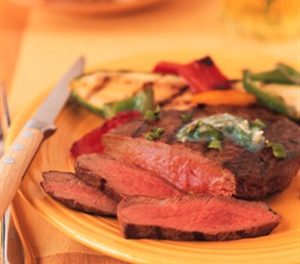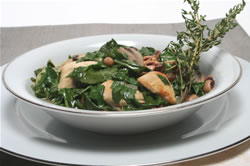At this time of year, when eggplant is at its peak, I am frequently asked how to pick one that is neither bitter nor seedy. With difficulty, is the answer. As produce experts agree, the two common beliefs about how to avoid these unpleasant characteristics are all, well, hooey.
Myth #1: Salting diced or sliced eggplant draws out bitterness. Salting does draw out water, making the flesh firmer and less of a sponge for oil. But it does not affect bitterness.
Myth #2: Male eggplants have fewer seeds than females, so are less bitter. Actually, all eggplants are part male and part female. (The so-called "male" eggplants are rounded at the blossom end, opposite the stem, while "females" are slightly indented.)
In truth, seediness depends on variety, maturity - and luck. And the eggplant's bitterness is related to its variety, maturity, the size of the seeds - and luck.
Chinese and Japanese eggplants, which taste sweeter, have fewer and smaller seeds. So do smaller, less mature American eggplants, regardless of color. (Younger, smaller eggplants taste milder, in part because their seeds are smaller.) Avoid the hot-house, so-called baby or miniature eggplants, which are imported from Europe. They can be startlingly bitter.
Age affects bitterness. After picking, eggplants increase in bitterness over time. Farmer's markets usually sell freshly picked ones. Buy and use them the same day, if possible.
I recommend those weighing about three-quarters of a pound and that feel light for their size, a true indication of fewer seeds. For the following recipe, use a small American eggplant. The softer flesh of Asian varieties falls apart before it cooks through.
Tomato, Zucchini and Eggplant Stacks
Yield: 4 servings
Ingredients
- Olive oil cooking spray
- 1 small eggplant, about 3/4 pound
- 3 Tbsp. grated Parmesan or Romano cheese, divided
- 1 medium zucchini
- Freshly ground black pepper
- 3 medium plum tomatoes
Directions
- Preheat oven to 375 degrees. Spray a coating of oil on a baking sheet.
- Slice top off eggplant. Cut eggplant lengthwise (from top to bottom) into 1/4-inch slices. Discard two outer slices. Coat four largest slices with cooking spray and place on prepared baking sheet. Sprinkle with 1 Tbsp. cheese. Reserve any remaining eggplant for another use.
- Slice zucchini lengthwise into four thin slices. Spray each slice on both sides with oil and arrange on top of eggplant. Sprinkle with 1 Tbsp. cheese and pepper. Cut each tomato into 4 slices. Arrange 3 slices, cut side up, on top of zucchini slices. Sprinkle with remaining cheese and pepper.
- Bake vegetable stacks until eggplant is tender, about 20 minutes. Serve warm or at room temperature. Stacks keep 2 days, tightly covered in the refrigerator. To serve chilled stacks at room temperature, first gently heat in a microwave in order to revive the flavors, and then allow them to cool down.
Per serving:
57 calories,
2 g. total fat (1 g. saturated fat),
9 g. carbohydrate,
3 g. protein,
3 g. dietary fiber,
78 mg. sodium.
AICR












